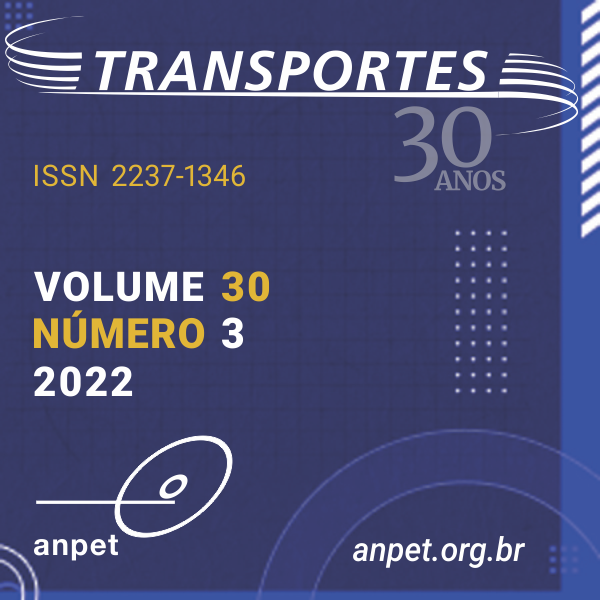Methodology for characterizing the mobility patterns of users of public bus systems through smart card data and spatial analysis
DOI:
https://doi.org/10.14295/transportes.v30i3.2749Keywords:
Mobility Patterns, Smart Card, Mobility Characterization, Public TransportAbstract
Considering the importance of the public transport system in promoting equity in access and sustainable transport, it is essential to know how the mobility patterns of users vary spatially and temporally. This paper proposes a method to assess the mobility patterns in the public transportation system using smart card data and spatial analysis. The method contributes to understand the relationship between the mobility patterns and the demand variation in Brazilian cities, where a major part of their population depends on public transportation for daily commuting. Thus, the method was based on hypotheses about the types of patterns, their spatial and temporal variability, and how they relate spatially to the public transport demand. The application of the method to the 2014 and 2018 data of Fortaleza's public bus system showed a great decrease in the number of users who live in peripheral areas, with the lowest levels of accessibility, and who use the system regularly to commute.
Downloads
References
Agard, B., Morency, C. and Trépanier, M. (2006) ‘Mining public transport user behaviour from smart card data’, IFAC Proceedings Volumes, v. 39, n. 3, p. 399–404. DOI: 10.3182/20060517-3-FR-2903.00211.
Bree, S., Fuller, D. and Diab, E. (2020) ‘Access to transit? Validating local transit accessibility measures using transit ridership’, Transportation Research Part A: Policy and Practice, v. 141, p. 430–442. DOI: 10.1016/j.tra.2020.09.019.
Briand, A. S., Côme, E., El Mahrsi, M. K. and Oukhellou, L. (2016) ‘A mixture model clustering approach for temporal passenger pattern characterization in public transport’, International Journal of Data Science and Analytics, v. 1, p. 37–50. DOI: 10.1007/s41060-015-0002-x.
Briand, A. S., Côme, E., Trépanier, M. and Oukhellou, L. (2017) ‘Analyzing year-to-year changes in public transport passenger be-haviour using smart card data’, Transportation Research Part C: Emerging Technologies, v. 79, p. 274–289. DOI: 10.1016/j.trc.2017.03.021.
Cats, O. and Ferranti, F. (2022) ‘Unravelling individual mobility temporal patterns using longitudinal smart card data’, Research in Transportation Business & Management, v. 43. DOI: 10.1016/j.rtbm.2022.100816.
Devillaine, F., Munizaga, M. and Trépanier, M. (2012) ‘Detection of activities of public transport users by analyzing smart card data’, Transportation Research Record: Journal of the Transportation Research Board, v. 2276, n. 1, p. 48–55. DOI: 10.3141/2276-06.
Diab, E., DeWeese, J., Chaloux, N. and El-Geneidy, A. (2020) ‘Adjusting the service? Understanding the factors affecting bus rid-ership over time at the route level in Montréal, Canada’, Transportation, v. 48, p. 2765–2786. DOI: 10.1007/s11116-020-10147-3.
Faroqi, H., Mesbah, M. and Kim, J. (2019) ‘Comparing sequential with combined spatiotemporal clustering of passenger trips in the public transit network using smart card data’, Mathematical Problems in Engineering, v. 2019, p. 1–16. DOI: 10.1155/2019/5070794.
Faroqi, H., Mesbah, M., Kim, J. and Tavassoli, A. (2018) ‘A model for measuring activity similarity between public transit passengers using smart card data’, Travel Behaviour and Society, v. 13, p. 11–25. DOI: 10.1016/j.tbs.2018.05.004.
Garcia, C. S. H. F., Macário, M. do R. M. R., Menezes, E. D. de A. G. and Loureiro, C. F. G (2018) ‘Strategic Assessment of Lisbon’s Ac-cessibility and Mobility Problems from an Equity Perspective’, Networks and Spatial Economics, v. 18, p. 415–439. DOI: 10.1007/s11067-018-9391-4.
Goulet-Langlois, G., Koutsopoulos, H. N., Zhao, Z. and Zhao, J. (2018) ‘Measuring Regularity of Individual Travel Patterns’, IEEE Transactions on Intelligent Transportation Systems, v. 19, n. 5, p. 1583-1592. DOI: 10.1109/TITS.2017.2728704.
Gomide, A. A. (2003) ‘Transporte urbano e inclusão social: elementos para políticas públicas’, Texto para discussão No 960, Insti-tuto de pesquisa econômica aplicada, Brasília.
Hawkins, J. and Habib, K. N. (2020) ‘Heterogeneity in marginal value of urban mobility: evidence from a large-scale household travel survey in the Greater Toronto and Hamilton Area’, Transportation, v. 47, p. 3091–3108. DOI: 10.1007/s11116-019-10041-7.
He, L., Agard, B. and Trépanier, M. (2020) ‘A classification of public transit users with smart card data based on time series distance metrics and a hierarchical clustering method’, Transportmetrica A: Transport Science, v. 16, n. 1, p. 56–75. DOI: 10.1080/23249935.2018.1479722.
He, L, Trépanier, M. and Agard, B. (2021) ‘Space–time classification of public transit smart card users’ activity locations from smart card data’, Public Transport, v. 13, p. 579–595. DOI: 10.1007/s12469-021-00274-0.
Kieu, L. M., Bhaskar, A. and Chung, E. (2015) ‘Passenger Segmentation Using Smart Card Data’, IEEE Transactions on Intelligent Transportation Systems, v. 16, n. 3, p. 1537–1548. DOI: 10.1109/TITS.2014.2368998.
Lima, L. S (2017) Espraiamento urbano por autossegregação e seus impactos na acessibilidade urbana de Fortaleza. Dissertação de Mestrado, Programa de Pós-Graduação em Engenharia de Transportes, Universidade Federal do Ceará.
Ma, X., Wu, Y. J., Wang, Y., Chen, F. and Liu, J. (2013) ‘Mining smart card data for transit riders’ travel patterns’, Transportation Research Part C: Emerging Technologies, v. 36, p. 1–12. DOI: 10.1016/j.trc.2013.07.010.
Mahrsi, M. K. El, Côme, E., Baro, J. and Oukhellou, L. (2014) ‘Understanding Passenger Patterns in Public Transit Through Smart Card and Socioeconomic Data’, The 3rd International Workshop on Urban Computing (UrbComp 2014), New York, NY, USA.
Martens, K. (2019) ‘Why accessibility measurement is not merely an option, but an absolute necessity’, in Silva, C., Pinto, N. and Bertolini, L. (ed.) Designing accessibility instruments: lessons on their usability for integrated land use and transport plan-ning practices. New York, NY: Routledge, p. 37–51.
Morency, C., Trepanier, M. and Agard, B. (2006) ‘Analysing the variability of transit users behaviour with smart card data’, in 2006 IEEE Conference on Intelligent Transportation Systems, Proceedings, ITSC, Toronto, ON, Canada. DOI: 10.1109/ITSC.2006.1706716.
NTU (2018) Associação Nacional das Empresas de Transportes Urbanos, Anuário NTU 2017-2018, Brasília.
Pelletier, M. P., Trépanier, M. and Morency, C. (2011) ‘Smart card data use in public transit: A literature review’, Transportation Research Part C: Emerging Technologies, v. 19, n. 4, p. 557–568. DOI: 10.1016/j.trc.2010.12.003.
Pieroni, C. B. V. (2018) Analysis of travel patterns from precarious settlements transit users in São Paulo through smart card data mining. Dissertação de Mestrado, Programa de Pós-graduação em Engenharia de Transportes, Universidade de São Paulo.
Pieroni, C., Giannotti, M., Alves, B. B. and Arbex, R. (2021) ‘Big data for big issues: Revealing travel patterns of low-income popula-tion based on smart card data mining in a global south unequal city’, Journal of Transport Geography, v. 96, p. 103203. DOI: 10.1016/j.jtrangeo.2021.103203.
Sousa, F. F. L. de M. (2019) Diagnóstico estratégico das desigualdades socioespaciais na acessibilidade ao trabalho em Fortaleza. Tese de Doutorado, Programa de Pós-Graduação em Engenharia de Transportes, Universidade Federal do Ceará.
Viallard, A., Trépanier, M. and Morency, C. (2019) ‘Assessing the Evolution of Transit User Behavior from Smart Card Data’, Trans-portation Research Record: Journal of the Transportation Research Board, v. 2673, n. 4, p. 184–194. DOI: 10.1177/0361198119834561.
Wang, Y., Wang, Y. and Choudhury, C. (2020) ‘Modelling heterogeneity in behavioral response to peak-avoidance policy utilizing naturalistic data of Beijing subway travelers’, Transportation Research Part F: Traffic Psychology and Behaviour, v. 73, p. 92–106. DOI: 10.1016/j.trf.2020.06.016.
Zaki M. J. and Meira, W. JR (2014) Data mining and analysis: fundamental concepts and algorithms. 2nd edition. Cambridge Uni-versity Press, Cambridge.
Zhang, S., Yang, Y., Zhen, F., Lobsang, T. and Li, Z. (2021) ‘Understanding the travel behaviors and activity patterns of the vulnerable population using smart card data: An activity space-based approach’, Journal of Transport Geography, v. 90. DOI: 10.1016/j.jtrangeo.2020.102938.
Downloads
Published
How to Cite
Issue
Section
License
Copyright (c) 2022 Renato Goersch Andrade Parente, João Lucas Albuquerque Oliveira, Ivana Maria Feitosa Silva, Francisco Moraes de Oliveira Neto

This work is licensed under a Creative Commons Attribution 4.0 International License.
Authors who submit papers for publication by TRANSPORTES agree to the following terms:
- The authors retain the copyright and grant Transportes the right of first publication of the manuscript, without any financial charge, and waive any other remuneration for its publication by ANPET.
- Upon publication by Transportes, the manuscript is automatically licensed under the Creative Commons License CC BY 4.0 license. This license permits the work to be shared with proper attribution to the authors and its original publication in this journal, and to be adapted for non-commercial purposes, provided appropriate credit is given and any derivative works are distributed under the same terms.
- Authors are authorized to enter into additional separate contracts for the non-exclusive distribution of the version of the manuscript published in this journal (e.g., publishing in an institutional repository or as a book chapter), with recognition of the initial publication in this journal, provided that such a contract does not imply an endorsement of the content of the manuscript or the new medium by ANPET.
- Authors are permitted and encouraged to publish and distribute their work online (e.g., in institutional repositories or on their personal websites) after the editorial process is complete. As Transportes provides open access to all published issues, authors are encouraged to use links to the DOI of their article in these cases.
- Authors guarantee that they have obtained the necessary authorization from their employers for the transfer of rights under this agreement, if these employers hold any copyright over the manuscript. Additionally, authors assume all responsibility for any copyright infringements by these employers, releasing ANPET and Transportes from any responsibility in this regard.
- Authors assume full responsibility for the content of the manuscript, including the necessary and appropriate authorizations for the disclosure of collected data and obtained results, releasing ANPET and Transportes from any responsibility in this regard.









